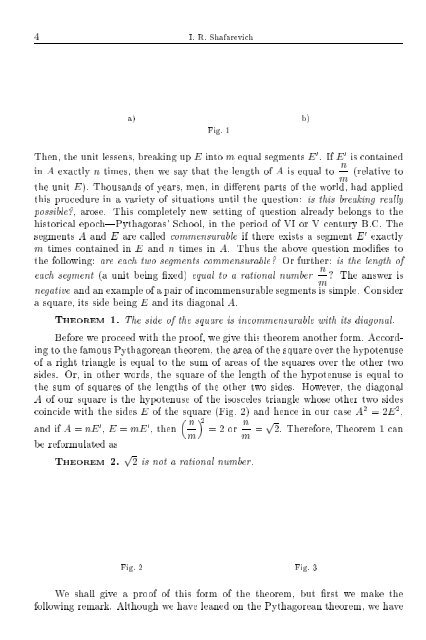4 I. R. <strong>Shafarevich</strong>a) b)Fig. 1Then, the unit lessens, breaking up E into m equal segments E 0 . If E 0 is containedin A exactly n times, then we say that the length of A is equal to n (relative tomthe unit E). Thousands of years, men, in dierent parts of the world, had appliedthis procedure in a variety of situations until the question: is this breaking reallypossible?, arose. This completely new setting of question already belongs to thehistorical epoch|Pythagoras' School, in the period of VI or V century B.C. Thesegments A and E are called commensurable if there exists a segment E 0 exactlym times contained in E and n times in A. Thus the above question modies tothe following: are each two segments commensurable? Or further: is the length ofeach segment (a unit being xed) equal to a rational numbern ? The answer ismnegative and an example of a pair of incommensurable segments is simple. Considera square, its side being E and its diagonal A.THEOREM 1. The side of the square isincommensurable with its diagonal.Before we proceed with the proof, we give this theorem another form. Accordingto the famous Pythagorean theorem, the area of the square over the hypotenuseof a right triangle is equal to the sum of areas of the squares over the other twosides. Or, in other words, the square of the length of the hypotenuse is equal tothe sum of squares of the lengths of the other two sides. However, the diagonalA of our square is the hypotenuse of the isosceles triangle whose other two sidescoincide with the sides E of the square (Fig. 2) and hence in our case A 2 =2E 2 , n 2 nand if A = nE 0 , E = mE 0 , then =2orm m = p 2. Therefore, Theorem 1 canbe reformulated asTHEOREM 2. p 2 is not a rational number.Fig. 2 Fig. 3We shall give a proof of this form of the theorem, but rst we make thefollowing remark. Although we have leaned on the Pythagorean theorem, we have
Selected chapters from algebra 5actually used it only for the case of an isosceles right triangle, when the conclusionis evident. Namely, it is enough to complete the Fig. 2 by constructing the squareover the side A (Fig. 3). From known criterions of congruency it follows that all vesmall right isosceles triangles in Fig. 3 are congruent. Hence they have the samearea S. But the square whose side is E consists of two such triangles and its areais E 2 . Thus, E 2 =2S. Similarly, A 2 =4S. Hence, A 2 =2E 2 , i.e. (A=E) 2 =2,which isallwe need.We cannow proceed with the proof of Theorem 2. Since our task is to provethe impossibility of representing p 2intheform p 2= n , it is natural to start withmthe converse, i.e. to suppose that p 2= n , where n and m are positive integers.mWe also suppose that they are relatively prime, for if they have a common factor,it can be cancelled without changing the ratio n . By denition of the square root,m2 n 2=the equality p 2= n nm means that 2 = mwe obtain the equality(1) 2m 2 = n 2 . Multiplying both sides by m2m2 where m and n are relatively prime positive integers, and it remains to prove thatit is impossible.Since there is a factor 2 on the left-hand side of (1), the question is naturallyrelated to the possibility of dividing positive integers by 2. Numbers divisible by2 are said to be even, and those indivisible by 2tobeodd. Therefore, every evennumber k can be written in the form k = 2l, where l is a positive integer, i.e.we have an explicit expression for even numbers, whereas odd numbers are denedonly by a negative statement|that such an expression does not hold for them. Butit is easy to obtain an explicit expression for odd numbers.LEMMA 1. Every odd number r can be written in the form r =2s +1,wheres is a natural number or 0. Conversely, all such numbers are odd.The last statement is evident: if r =2s +1were even, it would be of the formr =2l, which implies 2l =2s + 1, i.e. 2(l ; s) = 1, which is a contradiction.In order to prove the rst statement, notice that if the odd number r 6 2, thenr =1andtherepresentation is true with s =0. If the odd number r > 1, thenr > 3. Subtracting 2 from it, we obtain the number r 1 = r ; 2 > 1, and r 1 is againodd. If it is greater then 1, we again subtract 2 and put r 2 = r 1 ; 2. In this waywe obtain a decreasing sequence of numbers r, r 1 , r 2 , . . . , where each member isless than its predecessor by 2. We continue this procedure as long as r i > 1, andsince positive integers cannot decrease indenitely, we shall arrive at the situationwhen we cannot further subtract the number 2, i.e. when r i =1. We obtain thatr i = r i;1 ; 2=r i;2 ; 2 ; 2== r ; 2 ; 2 ;2=r ; 2i =1. Hence r =2i +1,as stated.We can now prove the basic property ofeven and odd numbers.LEMMA 2. The product of two even numbers is even, the product of an evenandanodd number is even and the product of two odd numbers is odd.
















